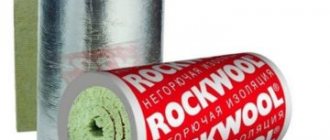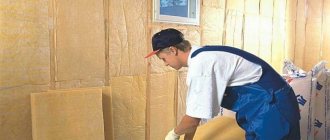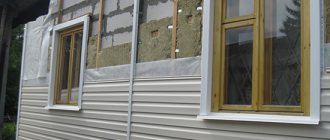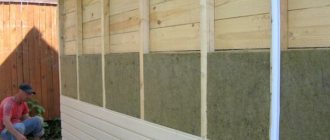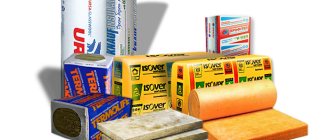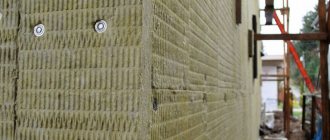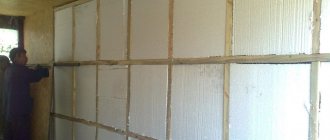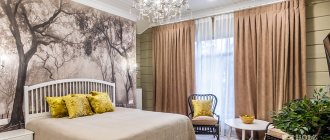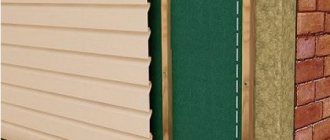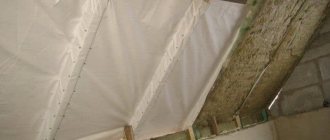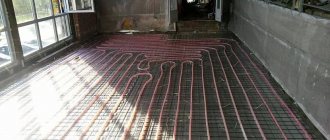Korovin Sergey Dmitrievich
Master of Architecture, graduated from Samara State University of Architecture and Civil Engineering. 11 years of experience in design and construction.
A vapor barrier for the external walls of a wooden house is needed when insulating with mineral wool. This insulation is very susceptible to moisture. Due to its high hygroscopicity, it is able to accumulate water. At the same time, the heat-shielding properties of the material are significantly reduced. To prevent unpleasant consequences, it is necessary to protect the mineral wool from moisture on all sides.
Why do you need a vapor barrier?
To protect against water from the outside, wind and waterproofing is used. It prevents the insulation from weathering and exposure to precipitation. An air ventilated layer approximately 50 mm thick is also usually provided, which allows dangerous condensation to be removed from the surface of the insulation.
Purpose of wall vapor barrier
But when designing the walls of a house, it is necessary to take into account that moisture can also come from inside the building. This is especially true for a wooden structure or any other built from vapor-permeable materials (for example, frame). To protect against moisture from the inside, a vapor barrier is used. It is needed to prevent the movement of vapors inside the walls of the house and prevents the mineral wool from gaining moisture.
wall pie
The “pie” of the wall consists of the following elements:
- Exterior finishing protects all subsequent layers from aggressive external influences, moisture and temperature fluctuations. It can be made of various materials. Siding, facade plaster, decorative stones, facing bricks - the choice depends only on your imagination;
- The waterproofing membrane is located under the exterior trim or wall sheathing. It creates conditions for a favorable microclimate in the room and ensures the safety of wooden frame elements from moisture. Waterproofing releases water vapor out, but does not let moisture in;
- Insulation is one of the most important components. It is placed between I-beams - in cells formed using horizontally located connecting links;
- The vapor barrier membrane prevents vapor from penetrating into the interior of the walls. Its installation is carried out on a wooden frame from the inside of the walls. Its installation is necessary in places where there is strong humidity (kitchen, bathroom, toilet). Wax paper often acts as a vapor barrier.
- Interior finishing is the final layer of the “pie.” The inner surface of the wall, if desired, can be covered with plasterboard, clapboard, etc.
Which material to choose
The construction market offers a wide variety of materials for installing a vapor barrier for a wooden or frame house. All of them are divided into two large groups:
A new material has also appeared, which is coating insulation. It is liquid rubber. The solution consists of polymers and is used in a liquid state. After application, the surface must be allowed to dry. The result of the work will be a film that is impermeable to vapor or liquid. But such vapor barrier is not applicable for the walls of a wooden or frame house. It will become a modern alternative to conventional materials when constructing a building made of brick and concrete.
For the case under consideration, traditional insulation with roll materials is needed. Before starting work, you need to find out how films differ from membranes, and what is better to make a vapor barrier when insulating with mineral wool.
Vapor barrier films
The use of materials of this type has become popular quite a long time ago. As the simplest option, builders use the usual polyethylene film. In this case, polyethylene can be smooth or perforated. Experts recommend using the first type for the vapor barrier. The thickness of the material must be at least 0.2 mm. For vapor barrier of house walls, it is recommended to choose two-layer films.
Polyethylene materials have a fairly large number of disadvantages. Disadvantages include:
- low tensile strength, the material is easy to damage during installation;
- low service life;
- preventing air movement (a greenhouse effect is created), it is necessary to pay increased attention to the ventilation of the building.
If holes or cracks appear in the film during installation, the protective ability will be significantly reduced. For this reason, it is necessary to carry out work carefully even with reinforced films. The advantage of polyethylene is its low cost and high availability (you can purchase it at almost any hardware store).
The second option for films is polypropylene. They are similar in appearance and properties to polyethylene, but do not have a number of disadvantages:
- increased strength;
- increased service life;
- resistance to overheating;
- reduced risk of cracks.
The vapor barrier membrane will not only protect the insulation from moisture, but will also allow the house to “breathe”
Many companies are involved in the production of vapor barrier membranes. They are often found in the product range of companies involved in the production of mineral wool or waterproofing protection. The material is a non-woven fabric and has the following positive characteristics:
- a reliable barrier to steam dangerous to the insulation;
- good air permeability, does not lead to a greenhouse effect in the building;
- safety for human health;
- environmental friendliness.
The disadvantages include the relatively high cost. When choosing which membrane you need, you should pay attention to its strength. There are types that do not have good resistance to tearing; they must be installed especially carefully.
When laying, it is important to strictly monitor which side of the material is facing the insulation. The manufacturer's recommendations must be strictly followed.
Insulating the walls of a wooden house from the outside with mineral wool
Insulating the outer walls of a wooden house with your own hands is not as complicated a process as it seems at first glance, and mineral wool is well suited for these purposes.
- Having secured the vapor barrier, they begin to lay slabs of insulating material using a construction stapler . In addition, the space between the slats is fixed to the wall using umbrella dowels .
- A waterproofing membrane is installed on top of the laid insulation , which will not allow moisture to pass through from the outside, but will remove a small amount of condensate that has penetrated the insulating layer;
- Next, slats are installed under the facing materials , which not only serve as the frame and decoration of the facade, but also form ventilation gaps necessary for ventilating the heat-insulating layer;
- Siding, lining, and blockhouse are often used as facing materials for wooden houses
Installation of sheathing on timber
Methods for insulating timber
Mineral wool insulation scheme
What types of building membranes are there?
To begin with, let’s take a closer look at what vapor barriers are and depending on their purpose. Based on their purpose, membranes used in construction work can be of the following types:
- vapor-permeable membranes;
- membranes with vapor barrier properties.
To protect mineral wool from moisture penetration, a layer of vapor barrier material is laid inside it. When insulating a roof or a room under a roof, such a film must be installed. The vapor barrier layer should be located below, under the layer of mineral wool. If you are going to insulate the walls on the inside of the building, you also need to provide a barrier to water vapor. In this case, you cannot use material that has pores or perforations. For more information about insulating walls from the inside, see the material: How to insulate walls from the inside of an apartment or house and how to do it correctly.
The vapor permeability coefficient of this layer should be as low as possible. It is preferable to use, for example, a film made of polyethylene (possibly reinforced). An aluminum foil coating on such a film would also be useful. Do not forget - when using a vapor barrier, the humidity in the insulated room will increase many times over. Therefore, it is necessary to think over a good ventilation system.
There are special films on which an anti-condensation coating is applied. Moisture does not accumulate on them. They are usually laid under materials that are susceptible to rust. These are corrugated sheets, galvanized sheets, and metal tiles (without a protective coating on the inside). The film prevents wet fumes from reaching the metal. To do this, on its reverse there is a rough fabric layer that collects moisture. The film with anti-condensation coating should be laid with the fabric side down, at a distance of 2 to 6 centimeters from the mineral wool layer.
Film with anti-condensation coating.
Construction membranes that allow vapor to pass through are used to insulate walls from the outside, protecting them from gusts of wind. They are also used in pitched roofs and unsealed facades as additional protection against moisture. Vapor-permeable films are required to have microscopic pores and perforations. Moisture accumulating in the insulation must pass freely through them into the ventilation system. The more active water vapor leaves, the better. After all, then the insulation dries quickly, and the effect of its use is higher.
Vapor-permeable films can be of the following types:
- Pseudo-diffusion type membranes allow less than 300 grams of water vapor per square meter to pass through per day.
- Diffusion-type membranes have a vapor permeability coefficient from 300 to 1000 grams per square meter.
- For superdiffusion type membranes, this figure exceeds 1000 grams per square meter.
Since pseudo-diffusion membranes protect well from moisture, they are convenient to use under the roof as an outer layer. In this case, it is necessary to provide an air gap between the film and the insulation. But such membranes are not suitable for facade insulation - they allow steam to pass through too poorly. After all, when it’s dry outside, dust can get into the pores of the membrane from the ventilation. So the film stops “breathing”, and condensation as a result settles on the insulation.
How to install vapor barrier of diffusion or superdiffusion type? Much simpler, as experience shows. Such a membrane has fairly large pore openings, and it is not so easy to clog them. Therefore, when laying it, you do not need to worry about the air gap for ventilation on the bottom side. This makes the task easier - you don’t have to bother with installing the sheathing and counter slats.
There are not only ordinary diffusion films, but also three-dimensional ones. They are designed so that the ventilation layer is located inside the membrane. Thanks to this, condensation does not reach the metal roof. The principle of operation of such a film is the same as that of an anti-condensation film. The difference is that the volumetric membrane removes moisture from the heat insulator. After all, if the metal roof is inclined at a small angle (from 3 to 15 degrees), then the condensation formed on the lower side cannot flow down. It slowly but surely undermines the galvanized coating, gradually destroying it completely.
Volume diffuse membrane.
Peculiarities
When insulating a house, you should carefully follow the correct sequence of actions and use only the best materials
Unfortunately, often owners who undertake to insulate their home themselves forget about one very important aspect - the vapor barrier. They install only insulation and don’t even think about the fact that it comes into contact with too warm or too cold air inside the room, and that condensation in the form of water droplets will soon begin to form on it
And this not only does not contribute to insulation, but also spoils the material itself - it moisturizes it, and if the steam does not yet have time to evaporate, mold appears and the insulation structure deteriorates. Moreover, taking into account our climatic conditions, a similar situation occurs at least four times a year - when the seasons change and, accordingly, the temperatures in the room and outside “conflict”, and the insulation becomes the battlefield.
That is why an important stage of insulation is the installation of a “vapor barrier”. The vapor barrier becomes an impenetrable obstacle to steam, preventing it from turning into water, as it “closes” it inside the room and prevents it from coming into contact with excessively warm or excessively cold air.
Vapor barrier can be made using several materials. From this set, three main types should be distinguished.
- Film. A solid vapor barrier that does not allow water vapor to pass through. One of the main advantages is low price. As a rule, it is made from polyethylene or butylene, their derivatives. Vapor-condensate films are two-layer with a smooth inner and rough outer surface. Lingering on the outside, drops of condensate do not flow down, but evaporate over time. In the case of a solid vapor barrier, you also need to take care of the air gap in order to avoid the greenhouse effect, but more on that later.
- Diffusion membrane. The main difference from film is that the membrane allows some of the vapor to pass through itself - but only the optimal amount that does not linger inside and evaporates instantly. Therefore, the vapor permeability of membranes is usually considered limited. The diffusion membrane is made of polymer film and polypropylene and has two sides.
- Reflective or energy-saving film. The outer layer of this film is metalized, which allows it to withstand high temperatures. Therefore, it is most often used in baths or saunas, reflecting part of the infrared radiation.
As you know, materials such as mineral wool, expanded polystyrene, and ecowool are used to insulate houses in modern conditions. Vapor barrier is also needed in the case of mineral wool insulation.
In fact, vapor barrier is always needed, no matter how expensive or high-quality insulation material you use. Mineral wool or mineral wool is otherwise the cheapest material, but its level of thermal conductivity is low, which reduces the likelihood of heat loss in the room. Rodents, mold, and mildew do not like mineral wool; it has high sound insulation and is easy to install. But it still requires a vapor barrier.
The most commonly used is a vapor-permeable limited diffusion membrane. It is laid against the walls, after which you need to lay mineral wool, and in symbiosis they allow the walls of the house to “breathe”.
The question of vapor barrier also arises when insulating a house with ecowool. In general, ecowool is loose cellulose fibers that have the ability to absorb warm moisture and still remain dry. Fungus and mold do not grow on it, the air in it simply does not get wet (if the change in humidity does not exceed 25% percent). From all of the above it follows that in the case of ecowool, the vapor barrier need not be attached.
Another popular insulation material, polystyrene foam, actually has another more common name: polystyrene foam. It applies to both external and internal surfaces, and in the case of external insulation of loggias, balconies or attic floors, it does not require a vapor barrier - it itself copes well with this if the insulation technology is maintained. But if you are insulating interior spaces with polystyrene foam, vapor barrier and waterproofing are required to avoid the formation of fungus, mold and getting the walls wet.
Video: Waterproofing or Vapor Barrier
The construction of a residential building or its renovation is a long-term work, the result of which must be quality. Vapor barrier is a film that, together with other structural objects, interacts to stop the formation of condensation. Usually people carry it out during major renovations. Hydro-vapor barrier helps to increase the service life because it prevents moisture from penetrating into the insulated layer.
In winter, vapor barrier is especially important, since the temperature indoors and outdoors is significantly different - this leads to the formation of steam in the house, which must leave the room without any obstacles. Basements, attics, first floors, and interfloor partitions most need vapor insulation.
The walls don’t really need it if they are insulated from the outside. A sign of this may be that the surface does not allow air to pass through:
- surface covered with non-porous coating;
- a thick, continuous layer of waterproofing is applied;
- wall made of bricks.
There are other situations where a vapor barrier is not necessary. From all this we can summarize that walls, floors and ceilings insulated with mineral wool do not necessarily need protection from condensation. Vapor barrier is necessary only in cases where there is constant contact of warm air flow with the surface in the room.
Hydro-vapor barrier is one of the most important factors when insulating a residential building with mineral wool. This fence will help you overcome the dampening of walls, floors or ceilings by condensation (the transition of a substance from a gaseous to a liquid state) when warm air comes into contact with the surface.
Rules for attaching a vapor barrier layer
The reliability of fastening depends on screws or nails. Regardless of the location of the room, hydro-vapor barrier is established by general principles.
For the integrity of the vapor barrier coating, it is important to apply the layer in a continuous layer to avoid any holes or cracks. It is advisable to fasten the sheet with a furniture stapler. With the help of this construction tool, the vapor barrier film is attached closely to the surface of the insulated walls and a certain ceiling.
The vapor barrier layer is laid by overlapping individual rolls or sheets (depending on the types of vapor barrier) by 10-12 centimeters. In places with door and window openings, the sheets must be glued; this can be done using adhesive tape specially designed for this situation. But there is no need to stretch the vapor barrier film, otherwise due to sudden changes in air temperature, it will not be able to maintain its integrity. It is attached with a margin of three centimeters.
Hydro-vapor barrier of a ceiling insulated with mineral wool or ecowool is also carried out with overlapping rolls or sheets. To protect the ceiling from steam and moisture, the interior and exterior of the room must be covered with waterproofing vapor barrier layers.
The outer part of the building should consist of three layers:
- paraisolating;
- thermal insulation;
- repeated vapor barrier.
Thanks to this, the service life is increased and the likelihood of condensation in your room is eliminated.
Floors made of reinforced concrete especially require protection from steam and moisture. Otherwise, sudden changes in air temperature will lead to the appearance of steam, which can cause fungus or mold to appear on the ceiling.
Mineral wool and its properties
The main indicator that shows the quality of insulation is the thermal conductivity coefficient of the material. Mineral wool is a fibrous insulating material. For such insulation materials, the thermal insulation qualities depend on the specific water content in the material (moisture content).
When any liquid gets in, mineral wool absorbs it, pushing out the air. As the amount of humidity increases, the thermal insulation properties of mineral wool decrease. The main disadvantage is that the liquid that gets inside is difficult to remove from the material. Mineral wool can absorb 2/3 of its entire weight in liquid, but its performance deteriorates.
Mineral wool
But despite the excessive accumulation of water, mineral wool has become widespread. In rooms where there is no constant contact with water, the use of this insulation is recommended.
Before insulating this material, it is important to cover the surface of these places with a special film that protects it from any moisture, but at the same time allows air flow to pass through:
- brick, frame walls;
- the outer side of the walls made of wood;
- floors;
- interfloor ceilings;
- the upper element of the building (roof).
Mineral wool can be made from various raw materials: glass, stone, or slag. Today, mineral wool is very popular in construction, in particular for room insulation. In particular, walls and ceilings are insulated with it. Mineral wool is also used for insulating furnaces and pipelines that have a high temperature, since this material is non-flammable. Additionally, mineral wool has soundproofing properties.
Mineral wool may contain potential dangers to the human body. But in fact, it contains fibers that are good for health. It is best to use it in a place that is regularly ventilated, or use ecowool. Ecowool consists of environmentally friendly materials.
Choosing insulation for a wooden house
Thermal insulation of timber walls can be carried out using facing bricks, concrete or ceramic stones, and small blocks . The only thing is that between the cladding and the surface of the wooden wall there must remain a designed air gap, which is provided in order to remove excess moisture from the wood.
The following can also be used as heat-insulating materials:
- Rock wool is a heat-insulating and sound-insulating material that is made mainly from igneous rock melts . It is a type of mineral wool. Gabbro-basalt rock is the raw material for making material fibers;
- Expanded polystyrene is an inexpensive, hygienically and sanitarily safe, lightweight but rigid material . Its insulating properties fully satisfy common requirements, but the possibility of cracks forming due to thermal expansion to which the walls are exposed does not allow us to call it the best solution for insulation;
- Ecowool is an absolutely natural, environmentally friendly, ideally soundproofing material , which consists of cellulose and antiseptics based on borax and boric acid. The material is moisture-resistant, hypoallergenic, and can be installed without creating seams or voids. Does not require the use of a vapor barrier layer when insulating timber walls;
- Basalt wool is characterized by excellent vapor permeability . Basalt is a non-flammable material, which provides fire protection for a wooden log house. The material has good noise insulation characteristics;
- Foam glass is foamed glass made up of thousands of cells of glass . The material is elastic, moisture-resistant, environmentally friendly, fireproof, very durable and can withstand any temperature fluctuations. It does not attract insects and prevents the formation of mold and mildew. Disadvantages include the lack of steam conductivity, high fragility and high cost of the material;
- In the case of wooden walls, mineral wool is ideal as a thermal insulator. It meets almost all the requirements for insulation, namely, it has a high thermal insulation coefficient, a minimum thermal conductivity coefficient and low hygroscopicity. She is not afraid of high temperatures, fungus, mold, insects and rodents. It perfectly copes with the removal of vapors to the outside, is non-toxic, non-flammable, breathable and, importantly, durable and can last from 30 to 60 years, based on the declared characteristics of the material.
The following materials are also suitable for insulation:
The range of modern insulation materials is very rich and varied, so the issue of choosing a heat-insulating material according to the technical features of the room, the requirements and budget of the buyer will not be particularly difficult.
Vapor barrier
The thermal insulation “pie” must allow air to pass through so that the room “breathes”. Therefore, the hot air flow escapes very slowly through the insulation fibers. With proper installation of insulation, this ability should increase from room to street.
There should be a ventilation gap of two centimeters under the decorative finishing of the walls and ceiling. Mineral wool is attached between the supports.
First, it is necessary to lay a wind and waterproofing barrier that will protect against precipitation and powerful gusty winds.
Partitions between rooms and interfloor ceilings need to be insulated using a different method, because air and moisture can impregnate mineral wool or ecowool from different sides, therefore, to preserve thermal and technical properties, a vapor barrier is required on both sides. In this case, residual moisture passes through the ventilation gap, which is located under the facade.
There are situations when hydro-vapor barrier when insulating with mineral wool or ecowool is not required at all.
For both waterproofing and vapor barrier, it is important to carry out a number of preparatory work:
- cleaning the coating from various dirt and dust;
- priming. This is necessary to seal surface cracks;
- drying the coating.
Vapor barrier of walls in the room
Let's look at the differences between external and internal insulation using the example of their advantages and disadvantages
Advantages of insulating wooden walls outside :
- External walls are additionally protected from dampness and solar activity, which increases their service life;
- Removing the dew point outside without the possibility of condensation;
- Providing highly effective thermal insulation;
- Preservation of room volumes;
- Possibility of sealing external holes and cracks;
Flaws:
- Changing the appearance of the building facade;
- high cost of work;
- dependence of work on the season and weather conditions;
External insulation under siding
Advantages of internal insulation :
- low cost;
- the possibility of leveling the walls;
- independence of work from the season and weather conditions;
Flaws:
- Shift of the dew point indoors and the likelihood of condensation and mold formation;
- Reducing the volume of the premises;
- Possible change in the interior for the worse;
Types of external insulation:
- Strengthening heat insulators to the wall surface using adhesive solutions and finishing with plaster;
- Non-ventilated walls in three layers. The insulating material is fixed with mortar and a single-brick external wall is installed, maintaining an air gap;
- Ventilated facade. The walls are protected with waterproofing material, on top of which insulating material is mounted. Then a wind barrier is installed, and the frame is sheathed with clapboard or any other siding. This method allows installation even in winter due to the absence of the need to use adhesive solutions.
Types of vapor barrier
Vapor barrier is divided into two types:
- Rolled. Rolls are rolled out from the bottom of the item to the top. Next, they are secured with slats made of wood in a horizontal position. The gap for ventilation is located between the inner lining and the steam protective layer. This hole should be about five centimeters. After the procedure, check that everything is securely fastened.
- Leafy. To work with sheet material, you should first install a profile frame. Sheets must be mounted into this frame. Self-tapping screws or nails will help you secure the sheets. The joint areas must be covered with polyvinyl chloride (PVC film). The vapor barrier layer sheet is placed with the inner area towards the place that you want to insulate.
Installation of vapor barrier on the floor
Preparatory work
Before installation, carry out the following steps:
- Now comes the time to seal cracks and gaps . They are sealed with sealants or jute fibers;
- Next, proceed to installation of the sheathing . bars measuring 50×50 mm or 50×100 mm are attached to the surface of the walls with self-tapping screws - they are selected according to the number of layers of insulation.
- The lathing is installed in the form of horizontally and vertically located guides with a distance between them almost equal to the width of the insulation - less by one cm, in order to more tightly join the material.
What is mineral wool?
Rock melts (basalts, dolomites) are used as raw materials for production. Sometimes industrial slags are added. The molten mass is formed into fibers, which are then pressed into slabs or rolls.
The strength of the final products is determined by the degree of compression during pressing and the binders, which use phenol-formaldehyde or urea resins.
The greater the force applied at the molding stage and the higher the concentration of binders, the more dense and rigid the material is.
Density, depending on the release form, can fluctuate within a very significant range:
- Rolls – 20-50 kg/m3;
- Mats –50-80 kg/m3;
- Lightweight slabs – 80-120 kg/m3;
- Medium hardness slabs – 120-200 kg/m3;
- Rigid slabs – over 200 kg/m3.
Common mistakes
In this scheme, the insulation structure approximately corresponds to that used when installing a warm roof. Most often, home-made workers make the same mistake - they lay mineral wool without waterproofing the outer surface. In this example, the walls perform the functions of a water barrier. In addition, there must be a gap between the vapor barrier and the decorative cladding to ensure normal escape of still warm air, but supersaturated with water vapor, from the surface of the vapor barrier membrane. Otherwise, condensation will appear, and the lining will become damp and swell with moisture.
Installation
It is possible to install a vapor barrier when arranging a balcony or loggia with your own hands. There is nothing extremely difficult in such work, but it is better to follow the step-by-step instructions if the master has not encountered such procedures before. We will find out step by step how exactly the installation of vapor barrier materials on a balcony area or loggia should take place.
Preparatory work
The preparatory process begins with proper insulation of the balcony area. Several strips of selected vapor barrier should be laid on a surface free of all debris and dirt. The premises require a thorough cleaning. All unnecessary items must be removed. It is recommended to dismantle the door frame and threshold.
All cracks should be sealed with cement and left to dry completely. Fastening of protective films is carried out using a specific technology:
if the installation is carried out on the outside, then the insulation must be installed there;
all internal installation work will require fastening with pre-laid mineral wool or other insulation material;
Expert: you need it when it comes to...
Hello. Steam insulation is certainly necessary, but not always. It is necessary to carry out insulation when it comes to cold pitched roofs, walls, interfloor and attic floors. In short, I strongly recommend making a vapor barrier in all places where there may be a risk of condensation. In this case, the insulation will last a long time.
What is mineral wool?
Rock melts (basalts, dolomites) are used as raw materials for production. Sometimes industrial slags are added. The molten mass is formed into fibers, which are then pressed into slabs or rolls.
The strength of the final products is determined by the degree of compression during pressing and the binders, which use phenol-formaldehyde or urea resins.
The greater the force applied at the molding stage and the higher the concentration of binders, the more dense and rigid the material is.
Density, depending on the release form, can fluctuate within a very significant range:
- Rolls – 20-50 kg/m3;
- Mats –50-80 kg/m3;
- Lightweight slabs – 80-120 kg/m3;
- Medium hardness slabs – 120-200 kg/m3;
- Rigid slabs – over 200 kg/m3.
How should additional floor insulation work?
So, when and why do you need to insulate existing floor insulation? The main goal of additional insulation is to improve its performance, as well as to ensure that the existing heat is distributed across the floor more evenly and for a long time. In all cases, when floor insulation works without additional thermal insulation, over time the floor heating system begins to not work at full capacity and, as a result, fails in the future.
In order for a floor heating system to function correctly and serve for many years, it must be organized wisely. To install heated floors, you can only use insulation that has a low level of thermal conductivity. What problems can additional floor insulation solve?
Types of membranes for floor insulation:
Types of membranes for insulation
How to choose an insulating membrane
Special equipment is used to install underfloor heating
Why does mineral wool get wet?
The thermal conductivity coefficient of mineral fibers is 0.031-0.042 W/m2 *K. This means that a layer of glass wool 5 cm thick is equal to the thermal effect of a meter-long brick wall. But the thermal insulation properties disappear when moisture penetrates the fibers.
Reasons for getting wet:
- The waterproofing membrane was damaged when laying insulation. They pulled the canvas too tight and accidentally pierced it with a nail or self-tapping screw.
- The film joints were not taped. As a result, condensation penetrates into the mineral wool fibers.
- The waterproofing near ventilation and chimneys was not fixed tightly enough.
- A low-quality diffuse membrane was used.
Risk of getting wet: the dangers of damp insulation
Wait for the wet roof insulation
will dry on its own - a dangerous misconception. Wet mineral wool does not retain heat. In addition, it becomes a source of unpleasant odors, the spread of mold and bacteria. Well, and the “cherry” in the troubles of the roofing pie: wooden rafters are destroyed, metal structural elements rust at an accelerated pace. The result is a major roof repair.
To avoid problems, check the condition of the insulation:
- if there are streaks or drops on the walls of the attic;
- cracks have appeared on the roof, the roofing elements do not fit tightly;
- In places where snow accumulated, the roof sagged.
